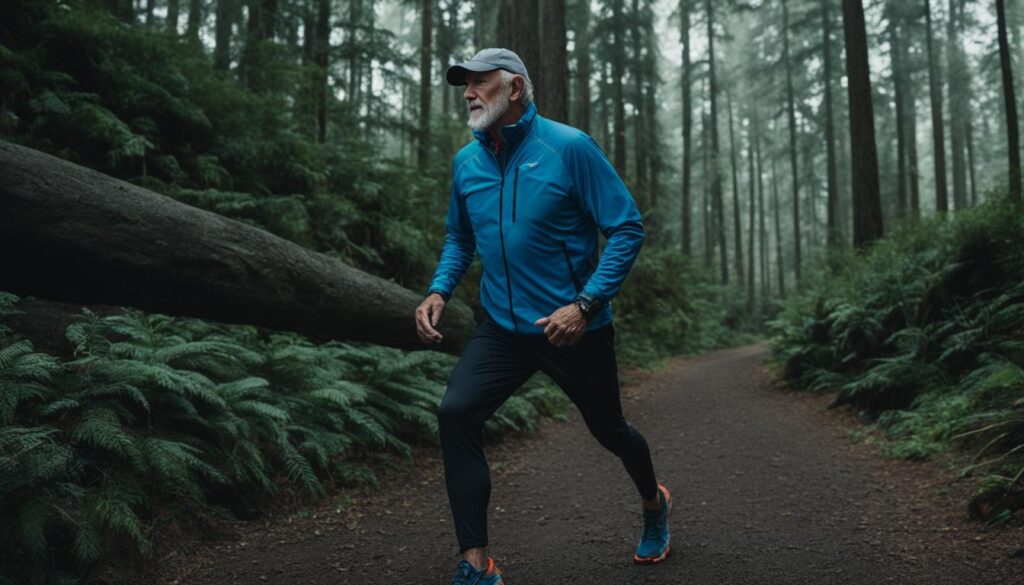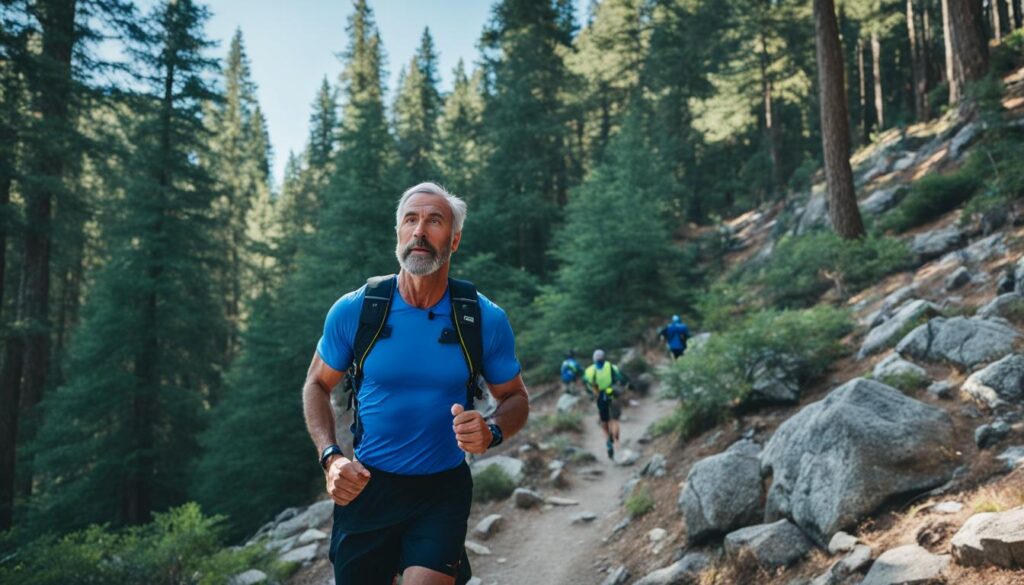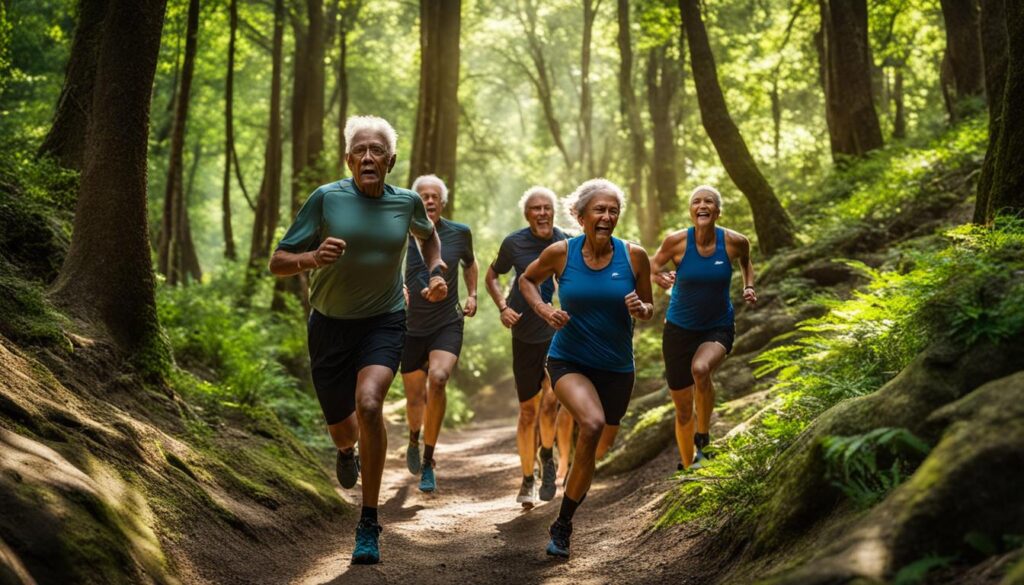Embarking on a new fitness journey like trail running over 50 can seem like a daring leap, yet it offers an exhilarating opportunity to bolster one’s health and discover untapped reservoirs of potential. Mature individuals considering beginning trail running will find a sport that respects their pace while guaranteeing a full spectrum of benefits ranging from improved balance to enhanced mental well-being. With the right trail running tips for older adults in hand, the trails can transform into a source of renewal and challenge that defies the conventional constraints of age.
Key Takeaways
- Beginning trail running at a mature age can significantly boost physical fitness and mental health.
- Appropriate preparation and training adjustments make trail running a safe and rewarding activity for older adults.
- Understanding the unique needs and challenges older runners face is crucial for injury prevention and enjoyment of the sport.
- Trail running for those over 50 encourages an active lifestyle and social connectivity, leveraging nature as a dynamic backdrop.
- Mature athletes are capable of excelling in trail running while paving the way for holistic health and adventure.
- Senior trail runners contribute to a diverse and inspiring community, demonstrating that age is not a barrier to outdoor sports.
The Allure of Trail Running for Aging Adults
The enchantment of trail running benefits for aging adults is undeniable, presenting a captivating blend of natural challenges and rejuvenating experiences. These outdoor adventures offer more than just traditional exercise; they provide a conduit to improved stability and a means to celebrate the grandeur of nature’s playground.

For those seeking the best trails for older runners, the key is finding paths that strike the right balance between being invigorating yet manageable. Trails that boast a mixture of terrain, scenic views, and clear markings tend to be the most alluring and senior-friendly.
Connecting with the earth underfoot, the sound of birds overhead, and the rustling of leaves in the wind, older adults are finding that trail running reignites a sense of youth. The camaraderie formed on the trails is as enriching as the physical activity, cultivating relationships that flourish amidst the shared bond of trail running.
| Benefits of Trail Running | Why It’s Great for Seniors |
|---|---|
| Better balance and coordination | Senior-friendly trails often feature even terrains that reduce the risk of falls. |
| Community and shared experiences | Group runs and trail clubs encourage social interaction and support. |
| Improvement in mental health | Natural settings help reduce stress and increase a sense of well-being. |
| Low-impact exercise | The softer earth is easier on the joints than pavement or asphalt. |
| Exposure to diverse terrains | Trail variation keeps the mind and body engaged, promoting cognitive and physical health. |
Ultimately, senior-friendly trail running is about inspiring aging adults to rewrite the narrative of their golden years—one trail at a time—opening up a world of wellness and shared adventure that defies age and redefines what it means to be an active senior.
Dispelling the Myths: Trail Running Over 50
As we look at trail running for those aged 50 and beyond, we find a treasure trove of inspiring narratives and crucial facts that dismantle long-held untruths. Foremost among these is the assumption that trail running naturally invites joint damage and lengthy recoveries. Instead, we see a host of successful endeavors where mature athletes have not just participated but thrived.
Understanding the Real Impact on Joints
It’s often argued that high-impact activities, such as running, might be detrimental to joint health, particularly in older adults. However, extensive research suggests otherwise. Trail running, with its varying terrain, promotes stronger joints and denser bones, thus serving as a natural buffer against osteoarthritis and similar conditions. Essentials for injury prevention for trail running in older adults include maintaining a moderate pace and choosing routes that match one’s fitness level.
Addressing Concerns on Recovery and Injury
When it comes to recovery and injury, the spotlight often turns onto the importance of rest and the right equipment. Ensuring adequate recovery time and selecting the best trail running shoes for older adults are key components to both mitigate injury risks and improve trail running experiences. Particularly, footwear with superior cushioning and support are considered advantageous for longevity on the trails.
Success Stories: Older Adults Excelling on the Trails
The annals of trail running are peppered with remarkable feats by senior runners, defying the typical narrative that depicts aging as a barrier. Giunnhild Swanson and Bob Hayes stand testament to the fact that toughness and endurance are ageless virtues. These success stories of older trail runners not only inspire but also illustrate the attainable nature of trail running for enthusiasts navigating their 50s and beyond.

| Aspect | Consideration for Older Adults | Beneficial Practices |
|---|---|---|
| Joint Health | Non-impactful to mild-impact trails | Choose softer surfaces and supportive footwear |
| Injury Prevention | Moderate distances and lower frequency | Implement strength training and flexibility exercises |
| Recovery | Longer rest periods and active recovery | Include low-impact activities like swimming or cycling |
| Success Stories | Seek inspirational narratives for motivation | Participate in age-appropriate trail running events |
Overcoming the trail running challenges for people over 50 is not only about physical preparedness but also about debunking myths that associate age with inability. As the inspiring stories and adaptive practices illustrate, trail running can be a rewarding endeavor well into one’s senior years.
The Health Benefits of Hitting the Trails in Your 50s
Embracing trail running after 50 marks not just a commitment to staying active, but also capitalizing on the remarkable health benefits of trail running for seniors. Contrary to common concerns, extensive research indicates that the sport can indeed foster joint integrity, thus staving off conditions such as osteoporosis and osteoarthritis, which are of particular concern to the aging population.
Apart from the well-documented physical perks, running trails for older adults equally contributes to mental wellness and cognitive function. The dynamic terrain and the serene natural environment provide an elevated running experience, translating to better sleep, a boosted mood, and sharper memory—an invaluable benefit as one navigates the golden years.
Frequent engagement with the trails has been linked to reduced cardiovascular mortality, a lower risk of heart disease and diabetes, and increased longevity. These findings articulate the importance of transcending the age stigma that often shadows vigorous physical activities for those in their later decades of life.
As we recognize the comprehensive benefits of trail running after 50, it becomes evident that starting or maintaining a habit of trail running can substantially enhance the quality of later life, contributing to a healthier, more spirited, and deeply satisfying senior living experience.

- Better bone health and increased muscle mass
- Improved mental well-being and cognitive function
- Extended longevity and vitality
- Reduced risks associated with cardiovascular health
The multi-dimensional workout provided by trail running not only strengthens the body but also fortifies the spirit, encouraging an active and engaged lifestyle that continues to reward well past the benchmark of 50 years.
Transitioning to the Trail: A Guide for First-Timers Over 50
Moving into the realm of trail running workouts for over 50 can mark the beginning of a thrilling new chapter in life. It is an activity that marries the enjoyment of nature with the fulfilling challenge of personal fitness. However, for beginner trail running for older adults, it’s crucial to start smart. Below, find fundamental strategies seasoned with beneficial tips to make your initiation into trail running training for over 50 a success.

Creating a Progressive Training Plan
Step by step and trail by trail, it’s important to foster endurance and physical adaptability through a carefully structured training plan. A progressive approach encourages you to begin with shorter, less intense runs, avoiding the common pitfalls of overtraining or injury.
| Week | Focus Point | Intensity Level | Total Distance |
|---|---|---|---|
| 1-2 | Acclimation | Low | 1-3 miles |
| 3-4 | Basic Endurance | Moderate | 3-5 miles |
| 5-6 | Strength | Moderate to High | 4-6 miles |
| 7+ | Trail Familiarization | High | 5+ miles |
The above table serves as a starting point—adjustment is key to respect your body’s responses and ensure gradual, sustainable progression. Better to be slow and steady than quick and injured, especially as a trail runner discovering their potential.
Mastering the Trail Run-Walk Method
Another cornerstone of nurturing trail running training for over 50 is the trail run-walk method. This method is particularly beneficial because it intersperses running with walking breaks, reducing the initial cardiovascular and muscular strain involved.
- Begin with running for 1 minute, followed by 4 minutes of brisk walking; repeat.
- Gradually reduce walking intervals each week until a comfortable run-only pace is achieved.
- Ensure you maintain a conversational pace—being able to talk indicates an appropriate intensity.
Trail running tips for those over 50 also stress the importance of enjoying the process. Celebrate each increase in running time or distance, no matter how small, as these are the victories that accumulate into significant transformations and enhance the enjoyment of trail running for life.
Essential Trail Running Gear for the Mature Athlete
For those embarking on the adventure of trail running over 50, equipping oneself with essential gear for trail running over 50 is not just about comfort—it’s about safety, performance, and enjoyment. Mature runners in particular should be attentive to selecting gear that supports their trail excursions, minimizing risks and maximizing pleasure. Let’s delve into the fundamental items that make up the trail running gear set for seasoned athletes.
Trail Running Shoes for Seniors: Starting from the ground up, the centrality of proper footwear cannot be overstressed. Look for shoes that provide ample traction, ensuring stability on loose gravel or slippery roots, and consider features like rock plates for foot protection. Seek out enhanced ankle support, which is particularly valuable for older runners to prevent twists and sprains.
| Feature | Benefit |
|---|---|
| Ample Traction | Stability on varied terrains |
| Rock Plates | Protection from underfoot obstacles |
| Ankle Support | Prevention of twists and sprains |
Protective Clothing: Beyond footwear, clothing acts as a shield against the elements. Breathable yet durable fabrics are ideal for balancing body temperature and buffering against branches or brambles. A lightweight, waterproof jacket is an indispensable addition to your trail running gear for mature runners, protecting you from unexpected downpours without the burden of extra weight.
- Moisture-wicking base layers
- Durable, quick-dry shorts or pants
- Waterproof, breathable jacket
Hydration is critical, and a quality hydration pack not only stows water but also features pockets for snacks, a phone, or a trail map. GPS watches and devices add a layer of safety and convenience, helping you stay on course and keep track of your progress.

Remember, investing in trail running shoes for seniors and proper attire can transform your trail running experience from a challenging outing into a pleasurable journey across every mile. With the right gear, mature runners can confidently take to the trails, assured that they are well-equipped to handle the demands of their trail-running adventure.
Injury Prevention: Trail Running Safely After 50
As we age, our bodies undergo changes that require a more calculated approach to physical activity to ensure staying injury-free while trail running over 50. Adhering to smart workout strategies and acknowledging physiological needs are crucial for injury prevention among older trail runners. This segment of our discussion emphasizes the need for trail running safety for older adults, providing actionable insights to help maintain your passion for trail running well into your later years.
Modifying Workouts for Injury Avoidance
To reduce the risk of injuries, modifying your regular trail running routine is essential. Adjusting the intensity, incorporating rest days, and alternating trail conditions can help create a balanced workout schedule. Embracing a variety of exercises and listening to your body’s response to exertion serve as fundamental steps in crafting a sustainable running regimen.
Understanding and Adapting to Age-Related Physical Changes
Recognizing age-related changes such as reduced muscle mass and bone density is paramount for older athletes. Implementing strength and flexibility training, along with an effective warm-up and cool-down, can enhance your body’s ability to handle the demands of trail running. Practices like yoga or Pilates can improve balance and flexibility, reducing the likelihood of falls and strains.
| Component | Purpose | Example Activity |
|---|---|---|
| Warm-Up | To prepare muscles and joints for exertion | Dynamic stretches, brisk walking |
| Strength Training | To improve stability and bone density | Bodyweight exercises, resistance bands |
| Flexibility | To increase joint mobility and decrease stiffness | Yoga, pilates |
| Recovery | To allow muscle repair and prevent overuse injuries | Foam rolling, adequate sleep |

The Psychology of Trail Running: Staying Motivated as an Older Runner
The pursuit of trail running motivation for seniors is a nuanced endeavor, blending the physical exertion of the activity with the robust fortitude of the mind. Its mental health benefits are as compelling as its physical perks, delving far beyond the superficial layers of fitness and into the core of emotional well-being. For the senior community, staying fit with trail running over 50 transcends the act of running; it becomes a personal narrative of mental agility and the power of perseverance.
Motivation for the mature runner lies in the embrace of nature’s canvas, the triumph over topographical challenges, and the warmth of companionship shared on the beaten paths. The zest for trail running germinates from within and is nurtured by an environment that is both physically invigorating and mentally stimulating. It requires a tapestry of strategies to remain vividly woven into the senior runner’s lifestyle.
The route to sustaining motivation is neither linear nor uniform. It demands an adaptable framework that caters to the diverse psyche of the senior runner. Progress may be measured not solely by time or distance but by the richness of the experience and the milestones of well-being.

To encapsulate the sentiment of endurance, a table of motivational stimuli versus mental rewards highlights not just the what, but the why, of trail running’s allure for the older athlete:
| Motivational Stimulus | Mental Reward |
|---|---|
| Embracing scenic routes | Rekindled sense of wonder |
| Overcoming physical barriers | Strengthened resolve |
| Regular running routines | Structured daily purpose |
| Goal setting and milestones | Acknowledgment of personal growth |
| Communal support systems | Shared sense of belonging |
| Variety in training | Continuous cognitive engagement |
Maintaining an active lifestyle through trail running is as much about fostering mental resilience as it is about physical upkeep. It is a conduit for seniors to reaffirm their agency, to reshape the contours of aging into a journey of empowerment and vibrance. As such, motivation becomes a confluence of inner drive and external inspiration, a balance struck between the yearning for movement and the solace derived from stillness.
By anchoring one’s running philosophy in the principles of consistency, adaptability, and personal satisfaction, older runners can continue to unravel the profound joys of trail running. In doing so, they illuminate the path, not just for themselves, but for future generations of senior trail runners seeking motivation beneath the canopy of the great outdoors.
Nutrition and Hydration Strategies for Older Trail Runners
As trail runners advance in years, their bodies require meticulous attention to nutrition and hydration to maintain peak performance on rugged terrains. Understanding trail running nutrition tips for older runners and trail running hydration for seniors is crucial for sustaining energy levels and preventing the potential deleterious effects of dehydration and nutrient imbalances during lengthy runs.
A comprehensive approach to diet can qualitatively enhance the trail running experience for the seasoned athlete. Ensuring a diet rich in complex carbohydrates, healthy fats, and lean proteins is key to a runner’s prolonged energy supply. Moreover, antioxidants and vitamins found in fruits and vegetables aid in recovery and bolster the immune system. As for hydration, older runners should aim to integrate a consistent schedule that balances fluid intake before, during, and after runs.

Senior trail runners may consider tailoring their nutrition strategies to their specific metabolic needs, which often include higher calcium intake for bone health and increased protein for muscle maintenance and repair.
To crystalize these principles into actionable items, the table below details a nutrition and hydration schedule tailored specifically for older trail runners:
| Timeframe | Nutrition | Hydration |
|---|---|---|
| Pre-Run (1-2 Hours Before) | Complex carbohydrates with moderate protein, e.g., whole-grain toast with almond butter | 500-700 ml of water |
| During Run (Every 15-20 Min) | Energy gels or small bites of banana | 150-250 ml of water or an electrolyte-replacement drink |
| Post-Run (Within 30 Min) | Protein-packed snack, such as Greek yogurt or a small smoothie | 500-700 ml of water, continue replenishing until urine is light yellow |
| Daily Hydration | N/A | 2-3 liters of water distributed evenly throughout the day |
Effectively managing trail running nutrition and hydration can significantly elevate an older runner’s vitality and stamina. It’s about fueling the journey just as much as enjoying the scenery—each step supported by strategic dietary choices. With these tools, older trail runners can confidently rise to the challenge, leaving no trail unexplored.
Training Programs Tailored for Trail Runners in Their 50s
Embarking on a trail running journey after 50 is not just about endurance; it’s a celebration of flexibility, strength, and the spirit of adventure. Tailored training programs for trail running over 50 ensure a holistic approach, taking into account the nuances of the mature body’s need for balance between vigor and vitality. The right blend of flexibility and strength training can be a game changer for older runners aiming to hit the trails with confidence and resilience.
Selecting the Right Training Regimen for Your Age Group
Choosing a training program that aligns with one’s age-related capabilities is crucial. For runners venturing into trail sports in their later years, selecting a regimen that emphasizes gentle progression and ample recovery time is essential. A combination of consistent, moderate-intensity aerobic exercises, flexibility training for seniors, and low-impact strength training makes for a comprehensive and attainable program.

Integrating Flexibility and Strength Training
Flexibility and strength are the cornerstones of a robust running program, especially for those over 50. Incorporating activities like yoga or Pilates can dramatically improve flexibility, aiding in fluid movement and reducing the risk of injuries. When it comes to strength, a focus on resistance training, especially trail running strength training for older runners, bolsters muscle endurance needed for tackling those challenging terrains.
| Week | Cardio Training | Flexibility Training | Strength Training | Rest Days |
|---|---|---|---|---|
| 1-2 | Walk/Run Intervals (20 min) | Yoga (30 min) | Bodyweight Exercises | 2 |
| 3-4 | Trail Running (30 min) | Dynamic Stretching (15 min) | Dumbbell Workout (20 min) | 2 |
| 5-6 | Increased Run Intervals (40 min) | Pilates (30 min) | Resistance Bands (20 min) | 2 |
| 7-8 | Continuous Trail Run (45 min) | Full Body Stretch (20 min) | Weightlifting (30 min) | 1 |
| 9-10 | Hill Repeats (30 min) | Tai Chi (30 min) | Strength Circuit (30 min) | 1 |
Selecting the appropriate intensity and variety of exercises within your training program is pivotal. It is recommended that seniors focus on control and form rather than the amount of weight lifted or the speed of completion. Adapting exercises to your current level of fitness will help prevent injuries and promote gradual improvement. Consistency and dedication to the training regime are instrumental in experiencing the full benefits of trail running, and more importantly, in fostering a sustainable passion for this invigorating sport.
Joining the Ranks: Trail Running Races and Clubs for Seniors
Embracing the challenges and rewards of trail running races for runners over 50, seniors around the United States are finding exhilarating opportunities for competition and socialization. Established organizations such as the American Trail Running Association cater to this age group with events and resources designed to foster community and celebrate the spirit of the sport.
Participating in races not only pushes the physical limits but also brings a sense of personal accomplishment and the thrill of shared achievement. Beyond competition, senior trail running clubs play a vital role, providing networks of support, camaraderie, and shared knowledge. These clubs are the backbone of trail running for older adults, offering a gateway to new friendships and a reinforcement of healthful, active living.

Dedicated events for masters athletes ensure that runners over 50 have access to races that are suitable for their experience and ability levels. Such events promote inclusiveness and encourage seniors to remain competitive, regardless of their age.
- Events tailored for senior runners
- Training advice and support from seasoned trail runners
- Resources and guides specific to trail running for older adults
As more seniors discover the joys of hitting the trails, the number of trail running races and clubs continues to grow. This enriching expansion ensures that the community is accessible to runners of all backgrounds and abilities. These platforms provide senior runners with the means to integrate fully into the vibrant and supportive world of trail running, ultimately enriching the lives of all who join their ranks.
Trail Etiquette and Safety: Running Responsibly Over 50
Adhering to trail running etiquette and prioritizing safety are cornerstones of an enjoyable trail running experience for older athletes. As the community of senior runners grows, respect for the trail and other users becomes imperative, as does the necessity to employ safety precautions to ensure not just personal well-being but also that of fellow trail enthusiasts.
Rules of the Trail for Senior Runners
For those braving the trails, understanding the right-of-way and how to share the space respectfully are fundamental. Key rules include yielding to faster runners and downhill traffic, staying on marked paths to minimize environmental impact, and being considerate of wildlife and fellow trail-goers. Here’s a quick guide to essential trail running safety for seniors and etiquette:
- Yield to runners heading uphill when you are going down.
- Keep music volume low or use one earbud to hear others approaching.
- Announce your presence when passing: A friendly “On your left!” works well.
- Leave no trace: Pack out what you pack in, maintaining the pristine nature of the trails.
- Respect signage, closures, and protected areas to ensure trail longevity and preservation.
Navigating Trails with Confidence: Tips for Safety and Enjoyment
Confidence in navigation and preparation for the unexpected are equally significant for ensuring a fulfilling outing. Elder runners equipped with a GPS device can roam undiscovered paths with more assurance, while adhering to safety tips such as sharing your planned route with someone or carrying a whistle can prevent emergencies. Incorporate these trail running tips for older athletes for a safe adventure:
| Tip | Description | Reason |
|---|---|---|
| Inform someone of your route | Always let a friend or family member know where you’re headed and when you expect to return. | Ensures that people are aware of your whereabouts should you get lost or injured. |
| Stay aware of your surroundings | Keep a vigilant eye for potential hazards like loose rocks, roots, and changing weather conditions. | Increases reaction time to avoid accidents and aligns with responsible trail running etiquette. |
| Carry a basic emergency kit | A kit including bandages, antiseptic wipes, and a whistle can come in handy during unexpected situations. | Prepares you for minor injuries and allows you to signal for help if you’re immobile. |
| Utilize a GPS device | Orient yourself with a GPS watch or smartphone app to keep you on track. | Reduces the risk of getting lost and can provide vital info about distance and elevation. |

By following these guidelines, senior trail runners can contribute to a safe and respectful trail running community, while also relishing the independence and exhilaration that comes with exploring nature’s paths with confidence and preparedness.
Customizing Your Own Trail Running Adventures After 50
Entering the world of trail running after the age of 50 offers a new and exhilarating way to stay fit and engage with the outdoors. Tailoring your workout to your particular needs, goals, and the varied terrains of nature can result in a deeply personal and rewarding experience. Trail running workouts for seniors can be adapted to suit individual fitness levels while emphasizing the enjoyment of the journey itself.
When it comes to custom trail running routes for experienced adults, the sky is the limit. Choosing the right path can be as important as the workout itself. By selecting routes with the perfect level of challenge and the most inspiring sceneries, the trail becomes not just a place to sweat but also to rejuvenate and refuel the spirit.

Trail running adventures for over 50s are not about trying to outdo others; instead, they offer a unique opportunity to conquer personal milestones. Here are some ideas for how you can tailor your adventures on the trails:
- Begin with a warm-up on gentle slopes to prepare your muscles and joints.
- Incorporate intervals of brisk walking or flat running stretches between more challenging inclines.
- Challenge yourself with increased elevation on some days, opting for flatter terrain when your body calls for a lighter workout.
- Mix running with hiking sections to enjoy the surroundings and give your body a different type of workout.
Figuring out a custom trail workout that hits all the right notes – from invigorating to achievable – is key. This could mean starting with shorter distances and gradually increasing your range, or incorporating different types of terrain to build your leg strength and endurance.
| Trail Running Element | Beginner Workout | Advanced Workout |
|---|---|---|
| Elevation Gain | Start with gentle hills | Incorporate steeper, longer climbs |
| Distance | 1-3 miles to start | 5-10 miles or more based on your conditioning |
| Terrain Type | Well-maintained trails with clear paths | Technical trails with rocks and roots |
| Pace | Comfortable enough to hold a conversation | Challenging, with intervals of increased speed |
By designing custom workouts and routes, you not only cater to your body’s needs but also invigorate your mind, grasping the reins on the thrilling pursuit that is trail running adventures for over 50s. Whether you’re on a solo journey or sharing the trails with peers, the trail running experience at this stage of life is rich with potential and ripe for the taking.
The Mental Game: Overcoming Barriers and Mental Blocks
For many seniors striving for improving speed and endurance for trail running over 50, the mental aspect of the sport can often present more of a challenge than the physical. Acknowledging this can transform a run from a trial into a potent experience saturated with the trail running mental health benefits, wherein each step becomes an opportunity for growth and empowerment.

Handling the Mental Highs and Lows of Endurance Running
Endurance running is a roller coaster of emotions, where highs can catapult you through beautiful vistas and lows can have you stumbling over the simplest obstacles. To navigate this emotional landscape, trail runners can embrace practices such as setting tangible goals and engaging in mental rehearsals that visualize success on the trails. Encouraging oneself through tough stretches and relishing the accomplishments helps in building mental fortitude.
Using Meditation and Mindfulness to Boost Trail Running Performance
Mindfulness in trail running serves as a powerful tool, enabling runners to tune into their body’s rhythm and the symphony of nature’s sounds around them. Techniques such as focused breathing or sensory awareness during a run can anchor one’s presence in the moment, thereby diminishing distracting thoughts and reducing the stress that can negatively impact performance.
| Mental Strategy | Benefits | How to Implement |
|---|---|---|
| Positive Visualization | Enhances focus, reduces stress | Imagine yourself conquering the trail successfully |
| Mindful Breathing | Regulates heart rate, calms the mind | Consciously focus on deep, rhythmic breaths |
| Sensory Awareness | Increases psychological presence | Pay attention to the feeling of your feet on the ground, the sounds of the environment |
| Self-Compassion | Promotes resilience, reduces self-criticism | Speak kindly to yourself, allow for imperfection |
By combining these mental tactics with regular physical training, senior trail runners can enhance their running experience and enjoy the full spectrum of mindfulness and mental health benefits that the sport has to offer.
Building Endurance: Trail Running Workouts for Seniors
For those committed to staying fit with trail running over 50, building endurance is pivotal. Tailor-made trail running workouts for over 50s are designed to improve stamina and promote long-term health. Adding a mix of interval training, hill repeats, and long, slow distance runs can enhance aerobic capacity and muscular endurance. It’s crucial to listen to your body and adjust the intensity to match your comfort level, proving beneficial for trail running exercises for older adults.

Cross-training activities such as cycling or swimming are effective complements to running, decreasing the likelihood of injury and contributing to overall endurance. With regularity and careful progress, these workouts lay the foundation for robust endurance, enabling seniors to relish the dynamic spirit of trail running.
| Workout Type | Description | Frequency | Benefits |
|---|---|---|---|
| Interval Training | Alternating between higher and lower intensities | 1-2 times per week | Boosts cardiovascular health and increases calorie burn |
| Hill Repeats | Running up and down a hill multiple times | Once a week | Builds leg strength and endurance, simulates trail conditions |
| Long, Slow Distance (LSD) Runs | Prolonged running at a conversational pace | Weekly | Improves aerobic capacity, teaches the body to use fat as fuel |
| Cross-Training | Engaging in non-running activities like swimming or cycling | 1-2 times per week | Reduces injury risk, enhances overall fitness |
Consistency is key to building endurance, and as we age, it becomes equally important to respect our body’s endurance and strength levels.
Ultimately, trail running workouts for over 50s should be about more than just the miles logged. They’re an opportunity to engage with nature, connect with fellow enthusiasts, and redefine personal fitness.
Conclusion
Embracing the trails as an individual over 50 doesn’t just stretch the legs—it stretches the bounds of what is possible. Delving into the world of trail running brings not only a surge of vitality but also a sense of community and achievement that belies the dates on a birth certificate. The myriad benefits of trail running for individuals over 50 include incalculable gains in physical health, such as increased muscular strength and improved cardiovascular resilience, as well as a clear, more vibrant mental state honed by the tranquility and wonders of the natural world.
Equally important to the seasoned runner is the social aspect, hence the rising popularity of trail running clubs for people over 50. These communities offer solidarity, shared experiences, and a touchstone for encouragement, which are just as critical as physical training. And when it comes to gear, especially footwear, the best trail running shoes for mature runners aim to maximize protection while ensuring comfort, proving indispensable allies in conquering varied and challenging terrains.
In the final analysis, trail running transcends age. With a commitment to training intelligently, selecting optimal gear, and engaging with the trail running community, athletes over 50 can revel in the discovery that the true essence of running knows no barriers of time. The call of the trails is clear—venturing into this enriching sport could be the start of the most rewarding chapters in life’s journey, inviting mature runners to redefine the landscape of their golden years.

